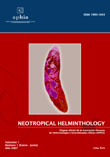STRONGYLOIDES STERCORALIS ASSOCIATED WITH NEPHRITIC SYNDROME IN A CHILD WITH INTESTINAL NEURONAL DYSPLASIA
DOI:
https://doi.org/10.24039/rnh2007111151Keywords:
Strongyloides stercoralis, complicaciones, glomerulonefritis, Perú.Abstract
Strongyloidiasis, caused by Strongyloides stercoralis, is a serious Public Health problem in Peru. We report the case of a two-year-old boy who was admitted at the Instituto Especializado de Salud del Niño in Lima with a diagnosis of intestinal obstruction associated with fifteen days of diarrhea, fever and cough. The histopathological examination of the necrotic tissue of colon showed intestinal neuronal dysplasia. During his hospitalization (12 days later) he presented hypereosinophilia (with 3,460 eosinophils/mm3), cough, fever and abnormal chest x-ray. Five days later, the eosinophil count reached up to 34,286 cells/mm3. One day later, S. stercoralis larvae were found in a direct stool smear. Serology tests for HTLV-1 and HIV were negative. Interestingly, our patient presented microscopic hematuria and high blood pressure during the highest levels of eosinophils in blood, therefore acute glomerulonephritis was suspected. Treatment with thiabendazole was readily started, and administered during seven days. After that, clinical findings disappeared and larvae were no longer detected in stool examinations. The patient was asymptomatic at discharged. This case presents strong evidence to be a hyperinfection of due to autoinfection triggered by the surgery as a stress factor.
Downloads
Published
How to Cite
Issue
Section
License

This work is licensed under a Creative Commons Attribution-NonCommercial-NoDerivatives 4.0 International License.
OBJETO: El AUTOR-CEDENTE transfiere de manera TOTAL Y SIN LIMITACIÓN alguna al CESIONARIO los derechos patrimoniales que le corresponden sobre la (s) obra(s) tituladas: xxxxxxxxxxxxxxxx, por el tiempo que establezca la ley internacional. En virtud de lo anterior, se entiende que el CESIONARIO adquiere el derecho de reproducción en todas sus modalidades, incluso para inclusión audiovisual; el derecho de transformación o adaptación, comunicación pública, traducción, distribución y, en general, cualquier tipo de explotación que de las obras se pueda realizar por cualquier medio conocido o por conocer en el territorio nacional o internacional.
REMUNERACIÓN: La cesión de los derechos patrimoniales de autor que mediante este contrato se hace será a título gratuito.
CONDICIONES Y LEGITIMIDAD DE LOS DERECHOS: El AUTOR-CEDENTE garantiza que es propietario integral de los derechos de explotación de la(s) obra(s) y en consecuencia garantiza que puede contratar y transferir los derechos aquí cedidos sin ningún tipo de limitación por no tener ningún tipo de gravamen, limitación o disposición. En todo caso, responderá por cualquier reclamo que en materia de derecho de autor se pueda presentar, exonerando de cualquier responsabilidad al CESIONARIO.
LICENCIA DE ACCESO ABIERTO: El AUTOR-CEDENTE autoriza que manuscrito publicado en La Revista Neotropical Helminthology permanece disponible para su consulta pública en el sitio web https://www.neotropicalhelminthology.com/ y en los diferentes sistemas de indexación y bases de datos en las que la revista tiene visibilidad, bajo la licencia Creative Commons, en la modalidad Reconocimiento-No comercial- Sin Trabajos derivados –aprobada en Perú, y por lo tanto son de acceso abierto. De ahí que los autores dan, sin derecho a retribución económica, a la Asociación Peruana de Helmintología e Invertebrados Afines (APHIA), los derechos de autor para la edición y reproducción a través de diferentes medios de difusión.


 Numero 2 Volumen 19 - 2025 (versión Anticipada)
Numero 2 Volumen 19 - 2025 (versión Anticipada)














































